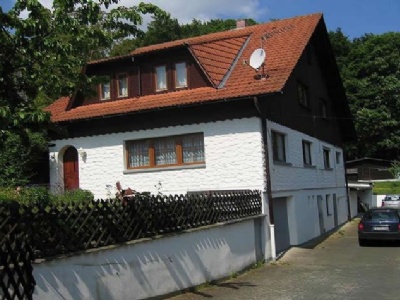Adlerhorst
In 1939, the Germans began building FHQ (Führerhauptquartier) Adlerhorst in the small town of Wiesental. At first, Hitler was supposed to use Adlerhorst when Germany attacked (Fall Gelb) Western Europe that same year. However, weather conditions in the autumn of 1939 did not allow Hitler to attack Western Europe and the attack was postponed several times. When it finally began in the spring of 1940 Adlerhorst was not ready. During the Western campaign Hitler used FHQ Felsennest as headquarters. Something Hitler pointed out was that his accommodation in Adlerhorst could not be too luxurious. He wanted to show solidarity with the soldiers in the field and demanded a more spartan accommodation. Adlerhorst was also intended to be used by Hitler during Operation Sea lion, the German codename for the intended invasion of the British isles. This never happened when the British air force could not be defeated. But during the German Ardenner offensive at the end of 1944, Adlerhorst finally came into use.
Adlerhorst consisted of seven bunkers, on top of the bunkers ordinary house was built which became a perfect camouflage. Adlerhorst was also located in a densely-grown forest area, which also contributed to the difficulty detecting it from above. Outside Wiesental, other buildings were built as part of the headquarters. The Americans mistakenly believed that Hitler had his headquarters in the castle of Ziegenberg about two kilometers below Wiesental. The road between Ziegenberg and Wiesental was camouflaged to avoid detection from the air. Hitler arrived at Adlerhorst on December 11 and remained there until January 15, 1945, when he returned to Berlin. Remaining in Adlerhorst was a small force that was tasked with destroying the headquarters so that it would not fall into the enemy’s hands. When American forces approached Wiesental in March 1945 everything was destroyed with exception of the Press house. When the Americans arrived at Adlerhorst, they found burnt-out houses but the unburnable bunkers remained, most of which were later destroyed by the Americans.
Current status: Demolished (2008).
Address: Obernberg, 35510 Butzbach.
Get there: Car.
Follow up in books: Seidler, Franz W. & Zeigert, Dieter: Hitler’s secret headquarters (2004).




The only thing that remains of the FHQ is some foundations, but on top of these post war houses has been built. Outside Wiesental and not in the FHQ itself, there are still buildings and bunkers standing as part of Adlerhorst. Press house, garages and a large guard bunker camouflaged as a barn. Adlerhorst is the only FHQ from which there are no photographs of either Hitler or anyone else. This has certainly contributed to the secrecy surrounding the headquarters. There were certainly photographs taken for both private and official use but for some reason these did not survive the war or they are somewhere waiting to be discovered.
Adlerhorst means the Eagle’s nest, but it is not the Eagle’s nest that has become best known after the war, rather, it is the opposite that this was the least known Eagle nest but at the same time the only Eagle nest that the Nazis themselves called the Eagle nest (Adlerhorst). There are actually three Eagle nests with different history and it is not always easy to keep them apart. The first and true Eagle nest was the aforementioned. The second Eagle nest is the house that is located on Obersalzberg, but the Germans just called it Kehlsteinhaus because it is located on the top of the mountain Kehlstein, but is known all over the world as the Eagle nest thanks to a French diplomat coined the term after a visit there at the end of the thirties. This house is also not to be associated with Hitler’s Berghof, which was located at the foot of Kehlstein mountain.
The third Eagle nest has really no connection what so ever with Hitler and Nazism but has received an indirect connection through Hollywood’s care. In 1968, Alistair MacLean’s Second World War spy drama, Where Eagles Dare, based on the book with the same name take place at Schloss Adler in the German Alps. In reality, the castle is called Burg Hohenwerfen (can be visited) and is located outside a small town called Werfen, Austria, about 40 kilometers south of Salzburg. Although the film was mostly shot in a studio, some outdoor scenes were shot in the castle courtyard. As you can see there is really nothing that unites these three Eagle nests except that the name has arisen in three independent ways.